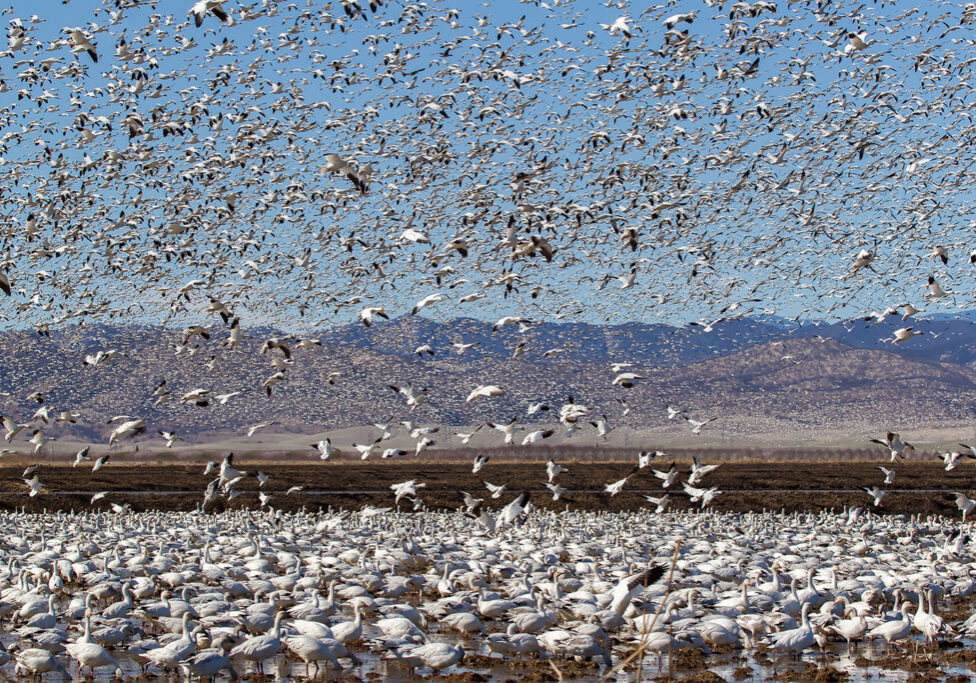Learn more about how Sacramento is taking action to conserve birds of the world here
The onset of autumn in the Sacramento Valley brings the promise of impending relief from hot weather along with hints of radiant fall foliage, as well as the first arrivals of migrating shorebirds, waterbirds, raptors and songbirds that are here only seasonally.
Ricelands and natural preserves in the Sacramento Valley attract millions of birds migrating from breeding grounds in Canada, Alaska and Siberia. Fall migrations typically begin with the arrival of Northern Pintail Ducks and flocks of various species of shorebirds in September. Greater White-fronted Geese take respite in the ricelands and other valley wetlands, reaching peak Sacramento Valley population by mid-November before resuming their migration to northern Mexico. These geese favor feeding in corn, wheat and rice fields, as well as bulrush marshes and other seasonally flooded wetlands.
Early autumn offers opportunity for birders to see great numbers of shorebirds, including Dunlin, Greater Yellowlegs, Least Sandpiper, Long-billed Curlew, Long-billed Dowitcher, Western Sandpiper, Whimbrel and Wilson’s Snipe.
LONG-BILLED CURLEW
Long-billed Curlews, the largest North American shorebird species, are federally protected in the United States, Canada and Mexico under the Migratory Bird Treaty Act. The U.S. Fish and Wildlife Service regards the Long-billed Curlew, part of the sandpiper family, as a “bird of conservation concern.”
They breed in the interior Pacific Northwest and in the Mountain West, and winter along the length of the Pacific Flyway. Their diet consists mostly of insects, including beetles, grasshoppers and caterpillars, as well as spiders, toads, and sometimes the eggs and young of other birds. Sunset is a good time to witness migrating Long-billed Curlews returning to their roosts after they’ve spent the daylight hours foraging for food.
MERLINS
Among migrating raptors, Merlins are notable for their early autumn appearance. The Merlin, a small falcon, feeds primarily on shorebirds, songbirds and other small birds that it stalks and overtakes in flight. They are also known to eat large insects, rodents, bats and reptiles. The breeding grounds of the subspecies Taiga Merlins range from Newfoundland west to Alaska and the far northern United States, but they winter in the western and southeastern United States. While in the Sacramento and San Joaquin valleys, Merlins forage around grasslands and agricultural fields, commonly in boggy rice fields. In California, the Merlin is regarded as a species of special concern.
NORTHERN PINTAIL
The Northern Pintail is a medium-sized Dabbling Duck that nests in arctic tundra or prairie grasslands in Alaska, Canada and the Northern United States. After wing molt, the slender Northern Pintails migrate to wintering grounds in the American Midwest and Atlantic states, and in California’s Central Valley, where they roost and feed in open, shallow wetlands and flooded agricultural fields. On average, 300,000 Northern Pintail flock to federal wildlife refuges in the Sacramento Valley each autumn, according to the National Audubon Society. In fall and winter, they primarily eat the seeds of grasses, sedges and pondweeds, and waste material in agricultural fields.
SANDHILL CRANES
After breeding in Canada and Alaska, Sandhill Cranes typically begin appearing in the Sacramento Valley in late September. The Greater Sandhill Crane, which is a state-listed threatened species, winters primarily in the Gulf states and in the Sacramento Valley as far north as Tehama County and in the San Joaquin Valley as far south as Kings County. The Central Valley wintering grounds of Sandhill Cranes encompass treeless grassland, soggy croplands with rice or corn stubble, and open wetlands. They’re often seen in large numbers in the Cosumnes River Preserve.
These omnivores eat insects, roots of aquatic plants, rodents, snails, frogs, reptiles, nestling birds, berries and seeds. They need fresh water for drinking and bathing, and therefore avoid brackish water.
Take advantage of the opportunity to see these travelers as they begin their autumn migration through the Sacramento Valley.










